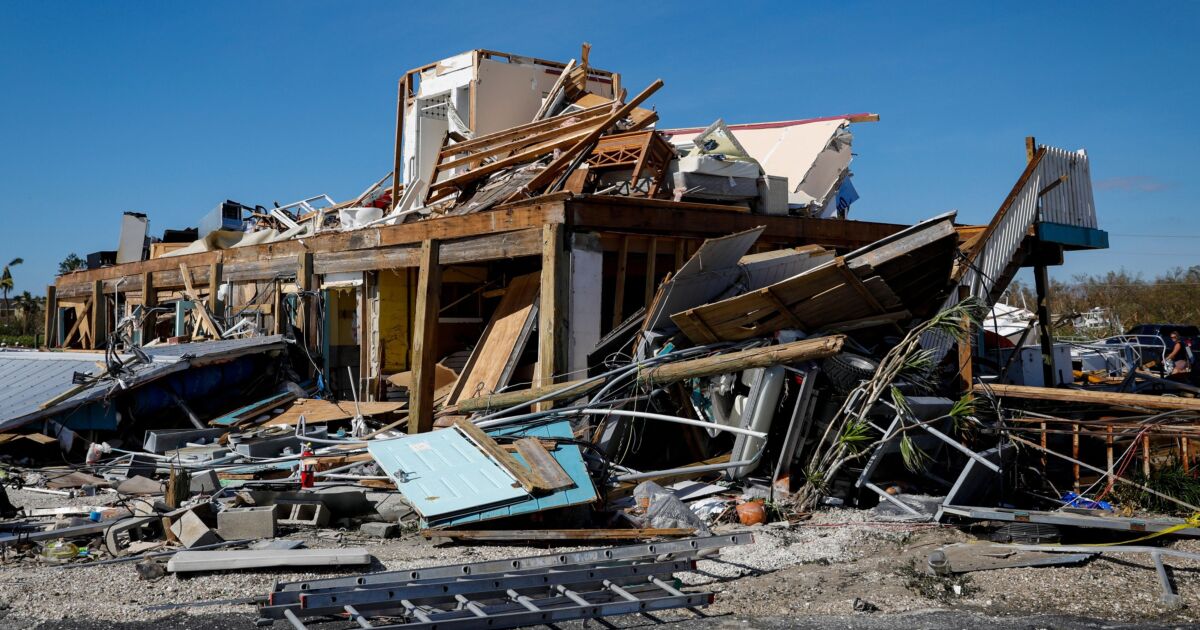Ian's wrath slams real estate as industry weighs climate risk

Hurricane Ian’s devastation could cost as much as $47 billion in damages to residential and commercial properties, affecting nearly 900,000 homes, a new CoreLogic analysis finds.
The storm, one of the most powerful to ever hit the U.S., slammed into the west coast of Florida on Wednesday as a Category 4 hurricane. It made a second landfall today as a Category 1 hurricane in South Carolina.
The climate disaster ravaged one of the nation’s healthier real estate markets and will have significant lasting impacts, according to CoreLogic economists.
“Hurricane Ian will forever change the real estate industry and city infrastructure,” said Tom Larsen, associate vice president of hazard and risk management at CoreLogic, in a press release. “Insurers will go into bankruptcy, homeowners will be forced into delinquency and insurance will become less accessible in regions like Florida.”
Wind losses alone for Florida residential and commercial properties are expected to cost between $22 billion and $32 billion, CoreLogic estimated based on National Hurricane Center data as of Sept. 29. Storm surge damage to properties could add an additional $6 billion to $15 billion.
The total damage from the most devastating storm to make landfall in Florida since Hurricane Andrew in 1992 could reach well into the billions of dollars. Approximately 887,221 residential properties could be hit by wind and/or storm surge, including 19,653 in the Cape Coral-Fort Myers area impacted by Category 4 hurricane forces, according to the firm’s analysis of additional data.
The Florida housing market posted one of the highest home equity gains in the country in the second quarter, and the highest home price gains in July, said Selma Hepp, interim lead of the office of the chief economist at CoreLogic.
“Gains in equity and record declines in loan-to-value ratios will provide many Florida homeowners with a financial buffer in case economic conditions worsen, as is typically the case following natural catastrophes,” she said.
The fallout could ravage the state’s homeowner’s insurance market, already a concern for lenders whose origination volume could be reduced by proposed insurer financial stability rating downgrades. Ian’s impact on the housing market and local mortgage lenders remains to be seen, but past climate tragedies haven’t swayed home prices or borrowing patterns to decline, said Janet Jozwik, managing director at RiskSpan, which provides data intelligence to the mortgage industry.
“After (Hurricane) Katrina, you saw spikes in repayment activities, some delinquency,” she said Wednesday before Ian made landfall, during a digital Housing Finance Strategies conference. “But those people, for the most part, recover either due to insurance payout or some sort of intervention, modification. So there’s limited, practical evidence of losses.”
State and federal regulators have already urged banks to work on loan adjustments with borrowers hit by both Hurricanes Fiona and Ian. Lenders and servicers are usually concerned about immediate physical dangers and events that could drive losses in their portfolio, which differs from consumers who may be more concerned about losses in equity, Jozwik said.
The mortgage industry is exploring pricing climate risks into its production, with some using tools to assess dangers, but the variety and volume of information makes a consensus among housing experts difficult, said John Bell III, executive director of loan guaranty service at the Veterans Affairs’ Veterans Benefits Administration.
Ryan Vaughn, climate risk analytics and research director at Freddie Mac, speaking in the same Housing Finance Strategies panel, described an example of that struggle in a scenario in which water has risen 2 feet deep in a house. Climate scientists aren’t interested in assessing the cost of damage to that home, and so other parties have to weigh all of the data.
“We need to recognize that there’s a lot of uncertainty in this,” he said Wednesday. “That’s all we really know. And then we can make informed guesses.”
Borrowers continue to flock to areas threatened by disasters like wildfires because of the tight market of the past two years, as many climate dangers aren’t currently priced into the market, experts said, Much of the danger is also in low income, minority communities less able to deal with the price shocks of a climate disaster, according to a Freddie Mac study last December.
“You don’t want to put someone into a house that they can’t afford 10 years down the road because it gets hit by a hurricane every other year,” Vaughn said. “Frequency of hurricanes is not something that climate models resolve well, just to caveat that.”
Editor’s note: This article has been amended to reflect that comments from Freddie Mac Climate Risk Analytics and Research Director Ryan Vaughn were made during Wednesday’s Housing Finance Strategies conference.



